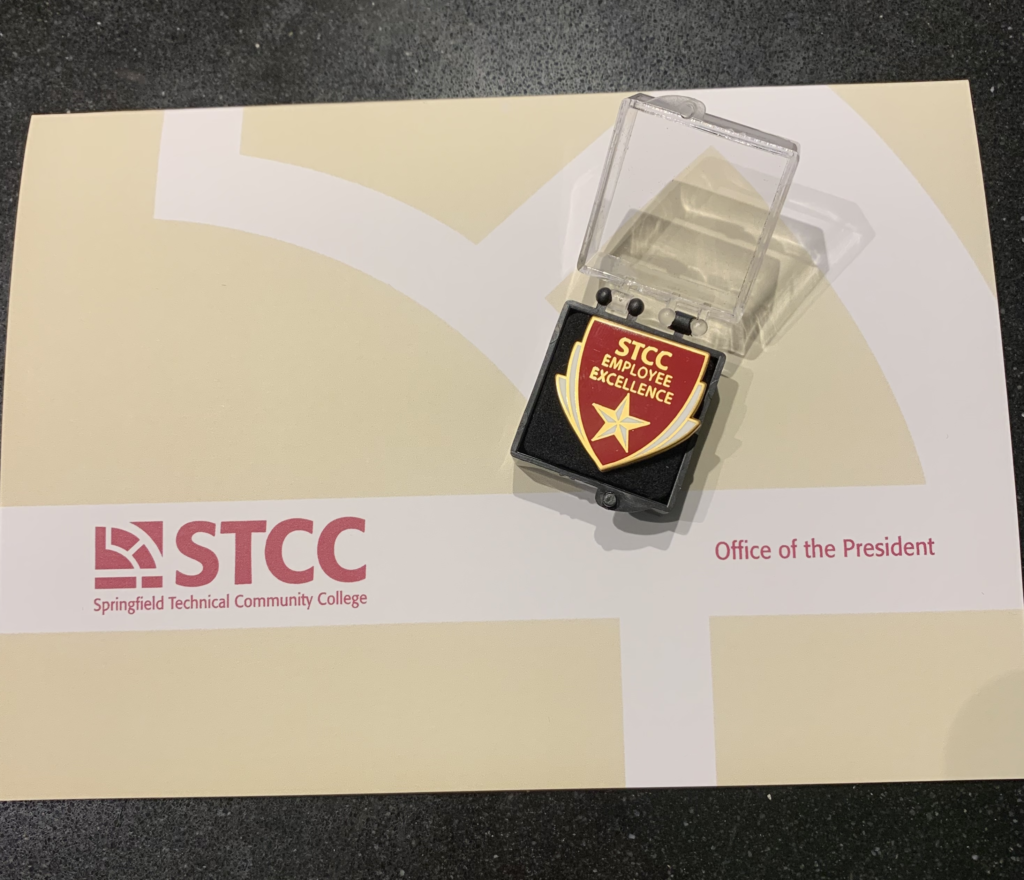Just got this in the mail for my work on the Antiracism and Inclusion Alliance [AIA] Committee. I am proud to stand in alliance with my minoritized colleagues and do the hard work in support of antiracism.

by izzy
Just got this in the mail for my work on the Antiracism and Inclusion Alliance [AIA] Committee. I am proud to stand in alliance with my minoritized colleagues and do the hard work in support of antiracism.

by izzy
I presented at the Massachusetts Colleges Online Conference on June 2, 2021 based on my article published in Faculty Focus Meet Them Where They Are: Furthering Your Own Cultural Humility and Responsive Teaching
the MCO session had participants brainstorming & sharing ideas to inject curriculum and pedagogical approaches into online course design covering the humanizing topics of: cultural humility, antiracism, and inclusion. What is? What if? What wows? What works? Participants arrived with ideas, ready to roll-up their sleeves, get messy, and leave with ideas to implement into their online classrooms and share to their campus.
What participants thought:
Thanks for the excellent presentations and the viewpoints.
Thank you! I added late but truly enjoyed it!
Thanks! Great session.
Thank you for a great session!
Thank you I am always Learning!
by izzy

Today, Faculty Focus published an article I wrote based on a poster I designed last summer. Book clubs, have been one of the most successful faculty professional development activities I’ve been involved in and I highly recommend them.
While only a few months of time have passed, since writing this article, I am seeing new better ways to consider emerging from research and literature. These are ‘changes in language’ that I am seeing, specifically when using the term culturally responsive teaching or pedagogy. There’s a changing over to using the language culturally sustaining pedagogy and I like the reasons why. The latter supports the students’ in their critique of the dominant power structures in societies.
This keeps the focus on the students’ and their languages, literacies, and cultural ways of being so as to stay centered in meaningfully and consistent learning instead of being considered as “add-ons.”
Yes, the concepts are tough and it will be changing, particularly when discussing antiracism. It is a process. My advice, gather your faculty, try a book club and talk about the ideas. We all learn better together and remember to meet our learners where they are.
by izzy
This conversation seems to be popping up in every one of my networks. We can not expect to return to what was. We must strive to transform our future.
If your institution expects life to return to normal post-pandemic, disappointment lies ahead.
Even with vaccines and a presidential administration strongly committed to traditional higher education, there are no guarantees that higher education as we knew it will bounce back — and that’s OK.
We must design for greater flexibility. Now that nontraditional students represent the new student majority, we need to offer an educational experience that better meets their needs. That will certainly mean making more courses available online and offering courses at times that will make it easier for students to combine their studies with work and caregiving responsibilities. It will require us to double down on the kinds of student services that pay off: intensive, targeted advising; degree mapping and career planning; bridge programs, supplemental instruction, tutoring and grants targeting retention and completion. It also means offering more on-campus jobs.
Rather than viewing the pandemic wholly negatively, we’d do better to consider it a hard-earned learning experience that has opened our eyes, challenged us and driven us to make long-overdue reforms.
As Steven Mintz is professor of history at the University of Texas at Austin states, “We’d be remiss if we failed to learn the pandemic’s lessons.”
by izzy
SPRINGFIELD, Mass. – Springfield Technical Community College had a long-term plan to ramp up online and digital learning.
But then came the COVID-19 pandemic, which forced instructional designers working as part of STCC’s Center for Online and Digital Learning to move faster than they ever imagined.
To maintain the safety of students, faculty and staff, STCC moved classes to remote instruction in March 2020. Instructional designers worked with faculty over the summer to prepare for fully online teaching in the 2020-21 academic year. STCC will continue to offer mostly online instruction through the spring semester, which begins Jan. 25.
Faculty and administrators acknowledge the abrupt change to remote learning created great challenges and, for some, led to a less-than-ideal learning environment last spring. The sudden need to vacate campus resulted in the use of a slew of digital tools to communicate with students including email, FaceTime, Google Hangouts, teleconferencing by phone and Zoom.
“Many faculty had been using online tools for the delivery of their face-to face classes. However, for those faculty who were not familiar with the digital space or whose courses required hands-on instruction, the ‘lift’ to online was great,” said Geraldine de Berly, vice president of Academic Affairs at STCC. “Since the summer, STCC invested in tools and training to assist faculty in developing the best truly online experience possible, including the hiring of a third instructional designer. Today, all online instruction occurs in a single platform, supplemented by class discussions using tools such as Zoom.”
The college anticipates spending nearly $800,000 through May 2021 in helping faculty develop hundreds of online classes and labs, de Berly said. Today, more than 80 percent of the credits are offered online, a jump from 12 percent prior to the pandemic. Over the coming year, STCC also expects to expand its online-only options in addition to its existing in-person and hybrid degree programs.
STCC will return to face-to-face, on-campus instruction when it’s safe to do so, but will continue to offer online options and apply digital tools to enhance the classroom experience, de Berly said.
The Center for Online and Digital Learning at STCC includes instructional designers Kyle Kraus, Marisha Marks and Mary Wiseman, with help from Scott Lambert, system administrator for online learning, and Andy Curto, senior technical specialist.
It’s a robust team compared to many other community colleges, which in some cases only have one person dedicated to instructional design. As the only technical community college in Massachusetts, the “T” in STCC’s name runs through every program and extends to online development.
“We support faculty in translating their courses into the online environment,” Wiseman said.
Wiseman said the pandemic has forced faculty and students to hone their digital literacy skills. Nearly a year after the pandemic moved students and faculty away from an “on-ground” or on-campus classroom experience, students and faculty are growing more comfortable with working at home behind their computers.
“While many of the faculty and students might have preferred an on-ground learning and teaching experience, the pandemic has given us the opportunity to really work on furthering and expanding our digital literacy skills,” Wiseman said.
STCC students and faculty use a learning management system called Blackboard which opens the door for multimedia learning and teaching experiences. Students and faculty use the digital tool to post and access articles, assignments, videos and more.
“For students who have been able to move forward during the pandemic, they have really invested in themselves and invested in their education and their futures,” Wiseman said.
STCC faculty who have gone through the online development program are encouraged to participate in additional professional development to gain insight into course accessibility, said Marks, who noted that 19 percent of undergraduate students nationwide have a diagnosed disability.
Learning disabilities are the most common, followed by visual and hearing impairments.
“With digital content, visual and hearing impairments are the areas that are most likely to create barriers,” Marks said.
Instructional designers are informing faculty about the types of disabilities they may encounter among students and offer help about presenting content in a manner that would be most beneficial to all learners.
Kraus, another instructional designer, applauded the faculty for their work.
“They have created hundreds of videos for students to interact and engage. They hold office hours virtually,” Kraus said. “I think people have really pulled together and have done the best they could to present to their classes virtually when they weren’t anticipating doing this anytime in the near future.”
To the students who are also continuing to take classes online amidst the pandemic, we can brag about it to the future generations and our grandkids that even a pandemic couldn’t stop us from getting our education.Aminah Bergeron, STCC student, mechanical engineering technology
STCC English Professor Denise “Daisy” Flaim has years of experience teaching students on campus in classrooms, so converting to the online experience was a big adjustment. But she worked closely with the online team at STCC to prepare for the transition. She feels confident going into the spring semester.
“Kyle Kraus has been amazing, helping me through all of this,” Flaim said.
“We’re learning technology, just as the students are learning technology,” Flaim added. “They have the COVID-related stresses, and this is so hard for them.
Dan Misco, an STCC alumnus and faculty member in the Digital Media Production program, considers himself well-versed in the online teaching world. Today, he teaches most of his classes online, but misses the face-to-face interactions with students in a classroom.
“I considered myself a face-to-face instructor,” Misco said. “I always excelled in the classroom. I liked being there with students to build a rapport with them.”
Misco said he empathizes with the students, some of whom have had difficulty getting through the online experience.
“I try to get in the heads of the students, and understand their worries and the parts they’re struggling with,” Misco said. “Some have struggled. I try to say, ‘OK, if I were in that position what would I be feeling and how do I make things a little bit easier for them?’”
One of Misco’s students, Jason Williams of Springfield, says it’s not easy balancing family responsibilities (he has two young children) and college work whether it’s face-to-face or online learning.
“I definitely miss being in rooms with my professors and other students,” Williams said. “It’s more difficult when you can’t see a presentation in person and have them come over to you and answer a question.”
But Williams sees the online experience as a learning opportunity. He studies digital audio broadcasting, where strong digital skills are critical to be successful.
STCC student Kimberly Quiñonez, a Springfield resident studying social work, expressed gratitude to the support from faculty over the past year.
“My experience as an online learner has really been amazing, although there were times I felt like quitting,” she said. “During those times my professors would reach out and check in with the class. In the very beginning I must admit that it was quite challenging transferring from an actual classroom to a computer. The classroom brought security to most students because questions were answered immediately. With online learning you may have to wait for a response through email.”
Quiñonez said the shift to online learning has sharpened her learning skills. “Most things that I didn’t believe I could do I did,” Quiñonez said. “Through following certain steps I realize that I can learn just by reading and not just by sound. Online learning has encouraged me to never stop believing in myself no matter how difficult it seems.”
Aminah Bergeron of Westfield, a mechanical engineering technology student at STCC, said she found benefits to online learning, noting she has “gotten the hang of it” after a year of studying from home.
“It wasn’t as difficult as I thought it would be. It was for sure different but a ‘good’ different,” Bergeron said. “I didn’t have to worry about getting ready, or making sure my house doors are locked or even thinking in the back of my head, ‘Did I leave the faucet running?’ I just had to open my laptop and start my schoolwork whether at my own pace or scheduled Zoom meetings. I also had much more time to research and not worry about calculating the time I’d lose on commuting to one location to another.
“I am looking forward to the upcoming semester in just a few weeks,” Bergeron added. “To the students who are also continuing to take classes online amidst the pandemic, we can brag about it to the future generations and our grandkids that even a pandemic couldn’t stop us from getting our education.”
(Click here to see a video featuring STCC‘s amazing team of instructional designers working at the Center for Online and Digital Learning. They explain how STCC has made a significant investment in digital literacy skills during the pandemic.)
Interested in applying to STCC? Visit stcc.edu/apply or call Admissions at (413) 755-3333.
About Springfield Technical Community College
STCC, the Commonwealth’s only technical community college, continues the pioneering legacy of the Springfield Armory with comprehensive and technical education in manufacturing, STEM, healthcare, business, social services, and the liberal arts. STCC’s highly regarded workforce, certificate, degree, and transfer programs are the most affordable in Springfield and provide unequalled opportunity for the vitality of Western Massachusetts. Founded in 1967, the college – a designated Hispanic Serving Institution – seeks to close achievement gaps among students who traditionally face societal barriers. STCC supports students as they transform their lives through intellectual, cultural, and economic engagement while becoming thoughtful, committed and socially responsible graduates.
MEDIA CONTACT:
Jim Danko, (413) 755-4812, jdanko@stcc.edu
by izzy
When students log in virtually on the first day of the new fall semester, they will begin an online learning experience that Springfield Technical Community College educators have been fine tuning all summer.
Online learning offers flexibility and quality
Mary Wiseman and Kyle Kraus, instructional designers at STCC, worked one-on-one with faculty to help them develop their online classes. Faculty will be using a number of digital tools including Zoom conferencing. STCC uses an online learning management tool called Blackboard to access course resources which include video, audio, PowerPoint slide presentations, graphics and more.
Wiseman is a big advocate of online learning, having studied the method for over 26 years. She highlights advantages to the approach, which include greater flexibility. Students who are juggling a busy schedule can access materials online 24/7 and complete the academic work at their own pace.
“An online experience is a very thoughtful, planned, unfolding of a course in the virtual space,” Wiseman said. “There’s a lot you can do online. It’s very exciting. When you take away the fact that somebody has to be at a particular place at a particular time, you take away a lot of constraints.”
Wiseman said online courses are as rigorous as face-to-face courses.
“I’ve been studying online for 26 years so I think it’s a really good way to continue your education and keep investing in yourself. You will never go wrong investing in your own education and your own self,” she said.

